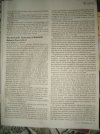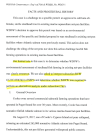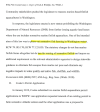A page from the NOAA biological opinion I am still reading thru:
Transfer of pathogens from an infected farm involve active and passive mechanisms. Good biosecurity measures can effectively manage active transfer mechanisms such as proper management of contaminated equipment and aquaculture vessel traffic frequency. Passive dispersal of pathogens from an infected farm is best managed by appropriate siting, and transfer kinetics depend on persistence of infectious pathogens outside of the host, particle transport features, and site-specific hydrodynamics. In an extensive assessment of risk presented by common pathogens of aquacultured Atlantic salmon in the Discovery Islands of British Columbia, Canada, a detailed Finite Volume Community Ocean Model (FVCOM) was applied to simulate passive particle tracking from farms to estimate dispersal trajectories (Chandler et al. 2017; Foreman et al. 2015a; Foreman et al. 2015b). This type of information can be used prospectively to inform appropriate farm siting. Hydrologic models can be coupled to an epidemiologic model to inform relative positions of farms. Salama and Murray (2011) demonstrated how pathogen transmission between farms could be affected by current flow, farm size (expressed in tons), and pathogen shed (either peak, ½ peak, or ¼ peak). For farms ranging in size from ~1,000 to 3,000 tons, separation between farms to avoid persistent outbreaks varied depending on the pathogen: 20-40 km for A. salmonicida, 10-20 km for ISAV and 100-200km for IPNV (the distance between the two Cooke farms - Orchard Rocks and Rich Passage, in PS is ~110 km.). The study also highlighted the importance of rate of decay of the pathogen. Although both ISAV and IPNV are very small viral particles, the slower decay rate of IPNV resulted in a ten-fold larger recommended distance. Although that study concluded that larger, widely separated farms were preferred to smaller, clustered farms, such modeling efforts are most appropriately conducted on a site-specific basis.
A similar model construction was used by Stucchi et al. (2011) to describe the transport and concentrations of sea lice (L. salmonis) in the Broughton Archipelago in British Columbia. The authors compared the results of their models to wild fish survey results and found that in areas where the model predicted low concentrations of infective sea lice stages, wild juvenile salmonids had a low prevalence of sea lice infection. If researchers are able to quantify and validate this correlation, they can then further develop regional disease management strategies for a pathogen where a vaccine does not exist.
A study by Mordecai et al. (2021) suggests the transmission of PRV-1 from farmed net pen fish (Atlantic salmon) to wild Pacific salmon in the northeast Pacific, but it is unclear if the farmed fish were initially infected or if they became infected after transfer to marine net pens. However, PRV has been present in northeast Pacific salmonids prior to the introduction of aquaculture to the region, with the earliest detection in wild steelhead in 1977 (Marty et al. 2015). Furthermore, none of the Pacific salmonids that were PRV-positive displayed any disease symptoms. A different diagnostic study of more than 2,200 Pacific salmonids detected PRV genetic material in four of the six species, although none of those fish displayed any disease symptoms (Purcell et al. 2017). An important caveat of results based on genetic detection is that pathogen presence does not necessarily indicate disease. In the case of PRV, which has not yet fulfilled Koch’s postulates as the etiological agent of disease in Pacific salmonids, the interpretation based solely on genetic detection should use caution.
Data from multiple locations world-wide strongly indicate that amplification of sea lice in salmon aquaculture has a negative effect on sympatric wild fish stocks, including population decline (Thorstad et al. 2015, Torrissen et al. 2013; Costello 2009). Although these conclusions are based primarily on correlations, the relationship is observed at multiple locations in the world and is associated with production cycles (e.g., Vollset et al. 2018). Because lice infestation is affected by temperature and salinity, farm siting criteria for salmonids should include considerations of both oceanographic and environmental conditions to reduce the potential for lice infestations (Brewer-Dalton et al. 2014). For example, sea lice survival and nauplii development is compromised at salinities below 29 and 25 parts per thousand, respectively (Bricknell et al. 2006; Johnson and Albright 1991), potentially explaining why sea lice are not problematic for Atlantic salmon net pens in PS. The negative effect of sea lice on the physiology and growth of cultured fish is a serious economic concern for aquaculture, and fish growers have a significant investment in minimizing and managing sea lice (Taranger et al. 2015). Programs for monitoring and controlling sea lice infestations, including integrated pest management (e.g., Brooks 2009), continue to be developed and tested worldwide (Torrissen et al. 2013).
Data from multiple locations world-wide strongly indicate that amplification of sea lice in salmon aquaculture has a negative effect on sympatric wild fish stocks, including population decline - not seeing the PR firms flag this finding...











